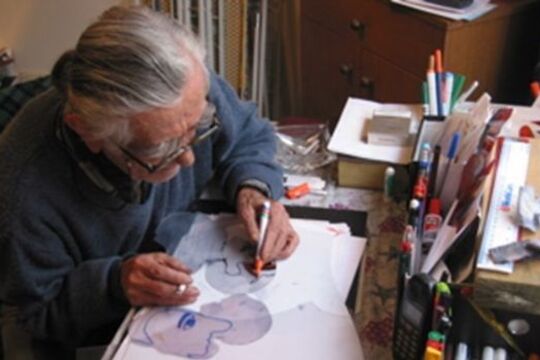Showing 2 items matching "Puppetry"
-

Dimitri Katsoulis, Greek Puppet Master
... Puppetry... with theatre and film companies as an actor and technician, as well as in shadow puppetry with masters of the art form. While earning a living in a Melbourne metal factory, he co-founded the Children's Theatre of Melbourne. Dimitri performed Greek shadow ...Traditional Greek shadow puppet theatre evolved from the Turkish model, which dates back to at least the 16th century.
The central figure is the character Karaghiozis, who relies on his wit and cunning to extricate himself from precarious situations. He and other characters are involved in humorous and satirical moral tales that comment on social and political life.
Dimitri Katsoulis immigrated to Melbourne in 1974 to escape the Junta regime that repressed Greek artists. He had trained in Greece with theatre and film companies as an actor and technician, as well as in shadow puppetry with masters of the art form. While earning a living in a Melbourne metal factory, he co-founded the Children's Theatre of Melbourne. Dimitri performed Greek shadow puppetry until 1991, exploring contemporary and controversial issues such as women's equality, and the isolation of migrant women and children.
-
 Wind & Sky Productions
Wind & Sky ProductionsMany Roads: Stories of the Chinese on the goldfields
... theatres were set up in larger towns and entertainers travelled from town to town presenting acrobatics, puppetry and opera to appreciative Chinese audiences. As the gold rush evolved, the easy shallow gold of the 1850s disappeared and mining techniques ...In the 1850s tens of thousands of Chinese people flocked to Victoria, joining people from nations around the world who came here chasing the lure of gold.
Fleeing violence, famine and poverty in their homeland Chinese goldseekers sought fortune for their families in the place they called ‘New Gold Mountain’. Chinese gold miners were discriminated against and often shunned by Europeans. Despite this they carved out lives in this strange new land.
The Chinese took many roads to the goldfields. They left markers, gardens, wells and place names, some which still remain in the landscape today. After a punitive tax was laid on ships to Victoria carrying Chinese passengers, ship captains dropped their passengers off in far away ports, leaving Chinese voyagers to walk the long way hundreds of kilometres overland to the goldfields. After 1857 the sea port of Robe in South Australia became the most popular landing point. It’s estimated 17,000 Chinese, mostly men, predominantly from Southern China, walked to Victoria from Robe following over 400kms of tracks.
At the peak migration point of the late 1850s the Chinese made up one in five of the male population in fabled gold mining towns of Victoria such as Ballarat, Bendigo, Castlemaine, Beechworth and Ararat. It was not just miners who took the perilous journey. Doctors, gardeners, artisans and business people voyaged here and contributed to Victoria’s economy, health and cultural life. As the nineteenth century wore on and successful miners and entrepreneurs returned home, the Chinese Victorian population dwindled. However some chose to settle here and Chinese culture, family life, ceremony and work ethic became a distinctive feature of many regional Victorian towns well into the twentieth century.
By the later twentieth century many of the Chinese relics, landscapes and legacy of the goldrush era were hidden or forgotten. Today we are beginning to unearth and celebrate the extent of the Chinese influence in the making of Victoria, which reaches farther back than many have realised.
